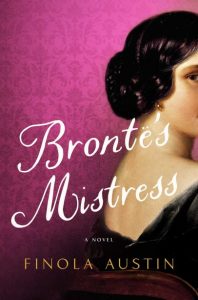The Brontë Myth: Why This Literary Family Continues to Inspire Writers Today

Photo by Nina Subiin
The Brontë Myth: why this literary family continues to inspire writers today
I first “met” the Brontës when my mother read my younger sister and me Jane Eyre. My sister hid under the covers at the “romantic bits.” I hung over the edge of the top bunk to beg for another chapter.
The story confused and compelled me. Jane was relatable and unrelatable all at once. She hated her school, while I loved mine. My days were spent bickering or playing with my sister, but she was absolutely alone. When I pictured being grown up, I was a Blanche Ingram, attending parties and flaunting new dresses. I didn’t want to believe that adults could remain on life’s peripheries. I already knew that, if I were in Jane’s place, I’d choose to live with Rochester in sin.
In high school, we studied Emily Brontë’s Wuthering Heights and the novel served as a different kind of introduction, this time to literary criticism. It was the first text I examined from a feminist lens and a Marxist one. There were academics, I discovered, who spent their entire lives writing essays on Brontë and the “twin motif.”
I read the other novels too—Charlotte’s and Anne’s—and dabbled in Brontë poetry, but my first real meeting with the family was thanks to Lynn Reid Banks’s biography, Dark Quartet: The Story of the Brontës. Four siblings and a widowed father in an isolated parsonage on the edge of a Yorkshire moor? I was hooked, like so many before me, by the “Brontë Myth.”
Now, more than twenty years on from my first encounter with Charlotte (and Jane), my own debut novel, Brontë’s Mistress, based on one of the most dramatic true stories behind England’s most famous literary family, is being published.
And I’m not the only writer finding inspiration in the Brontës. Scan the shelves of today’s bookstores and you’ll find Charlotte, Emily and Anne playing detectives, the events of Wuthering Heights retold from Nelly Dean’s perspective, and the truth about Heathcliff’s lost years. And that’s just the tip of the iceberg.
So, what is it about the Brontës that captures the writerly imagination? Here are my theories:
Childlike Play
Children like to play make-believe but most of us grow out of it—except writers. The Brontë siblings were incredibly imaginative, creating the worlds of Gondal and Angria together, fantasies they continued well into adulthood. If you’re not a writer, this may seem a little, well, odd. But for writers, this behavior is more understandable, even enviable. In my novel, these childhood tales form the backdrop for seduction, as the Brontë brother, Branwell, becomes closer with his employer’s wife.
The Shadow of Death
It’s been said that every story is about a potential death—whether a literal death, a metaphorical one, or a social one. The Brontës’ early deaths are well-known and they also suffered heartbreak when they were very young, with the loss of their mother and two older sisters. Writers see the potential and beauty in tragedy, making the Brontës compelling subjects. In my novel, my protagonist, Lydia Robinson, also begins the story under the shadow of death, having lost both her young daughter and mother within a year.
Isolation
Many writers have a love/hate relationship with isolation. They long for it to be able to write, yet they also write to create a connection with a reader—real or imagined. The isolation of the Brontës’ lives makes their story more extraordinary. Just how, people ask, was such genius born into obscurity? Charlotte’s heroines in particular are often isolated due to their youth, plainness and poverty. I wanted to write a novel in which the main character was older, beautiful and wealthy, but still isolated due to the strictures placed on all women in the nineteenth century.
Rejection
Writers are notoriously bad at dealing with rejection, yet there are few professions in which you must face so much of it. From querying agents to submitting to publishers to reading one-star reviews, there is a host of rejections to deal with along the way.
Rejection is also core to the Brontë Myth: publishers rejected the Brontës again and again, while poet laureate Robert Southey told Charlotte not to be a writer at all. We all love an underdog story, which is why we enjoy hearing of the Brontë sisters’ triumph. But what of Branwell, who never heard that magic “yes,” and, what’s more, dealt with rejection in his love life too?
There are Brontë fans all over the world who remember their first encounter with Jane Eyre, and who will debate the merits of Charlotte vs. Emily vs. Anne without resolution. Some of you are reading this article, and many of you are writers, or dream of being writers one day. With my novel approaching publication, I’m most excited to share yet another facet of the myth with Brontë lovers. I hope you meet Charlotte, Anne, Branwell and the others all over again in these pages.
Biography
Finola Austin, also known as the Secret Victorianist on her award-winning blog, is an England-born, Northern Ireland-raised, Brooklyn-based historical novelist and lover of the 19th century. Her first novel, Brontë’s Mistress, about Lydia Robinson, the older woman who had an affair with the Branwell Brontë, will be published in August 2020 and is available for preorder now. By day, she works in digital advertising. Find her online at www.finolaaustin.com.
Social Links
www.facebook.com/FinolaAustinWriter
www.instagram.com/finola_austin
https://www.goodreads.com/finolaaustin
Brontë’s Mistress
 “My whole life has been waiting. Waiting to be asked, waiting to be visited. Human beings must have action, or they will make it themselves.”
“My whole life has been waiting. Waiting to be asked, waiting to be visited. Human beings must have action, or they will make it themselves.”
Yorkshire, 1843: Lydia Robinson—mistress of Thorp Green Hall—has lost her youngest daughter and her mother within the same year. Now, with her teenage daughters rebelling, her hateful mother-in-law breathing down her neck, and her marriage grown cold, Lydia finds herself yearning for something more.
Change comes with the arrival of her son’s tutor, Branwell Brontë, brother of her daughters’ governess, Anne Brontë, and of those other writerly sisters, Charlotte and Emily. Handsome and romantic, a painter and a poet, Branwell is also twenty-five to Lydia’s forty-three. Colorful tales of his sisters’ elaborate playacting and made-up worlds form the backdrop for seduction, and soon Branwell’s intensity and Lydia’s loneliness find a dangerous match in each other.
Meanwhile, Mr. Brontë has his own demons to contend with, and grave consequences for Lydia’s impudence loom. Her prying servants blackmail her for their silence, her husband becomes suspicious as his health declines, and Branwell’s behavior grows increasingly erratic while whispers of the affair reach his bookish sisters.
With this swirling vortex of passion and peril threatening to consume everything she has built, the canny Mrs. Robinson must find the means to save her way of life, and quickly, before clever Charlotte, Emily, and Anne reveal all of her secrets in their deceptively domestic novels.
That is, unless she dares to write her own story first.
Deliciously rendered and captivatingly told, Brontë’s Mistress reimagines the scandalous affair that has divided Brontë enthusiasts for generations and gives voice to the woman vilified by history as the “wicked elder seductress” who allegedly brought down the entire Brontë family.
Category: Contemporary Women Writers, On Writing






























